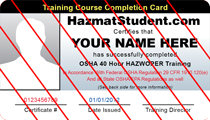7 HAZWOPER Training Tips
The OSHA HAZWOPER standard 29 CFR 1910.120 requires certain types of workers to get Hazardous Waste Operations and Emergency Response training. The training requirements vary depending on the type of work and the potential hazards faced, but all of the requirements aim to help protect workers from hazardous substances and hazardous wastes that may be encountered in the workplace.
Workers who fall under the OSHA HAZWOPER standard can find it difficult to choose the right course and complete their training, due to the many HAZWOPER training options available. To assist, we have compiled 7 HAZWOPER Training Tips that will help you navigate the training requirements and find the right HAZWOPER training for your situation. Download or print our HAZWOPER Training Tips Infographic.



